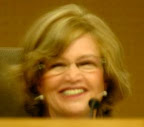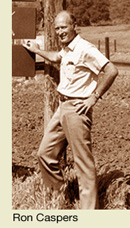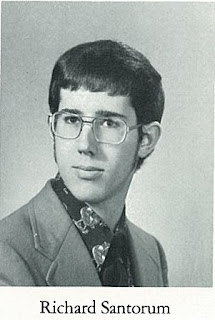 |
| Irrepressible |
[See Tere's
Board Meeting Highlights.]
It's 6:00 p.m., and there's no sign of the board. There're about fifteen people scattered amongst the seats of the
Ronnie Reagan Board Room. People are starting to drift inside on this wet, cold night.
I'll let you know if anything actually happens.
6:15 - No sign of the trustees yet. One item on tonight's agenda is acceptance for "review and study" the District Academic Calendar Committee's recommendation for the 2013-2014 Calendar, which is this:
 |
| Click on graphic to enlarge it |
Now, everybody's got an opinion about the proposed calendar. Just don't get pissed at
me if you don't like it. I've got nothing to do with it. They won't be approving it tonight, so you've still got time to shriek and moan. Just not to me.
6:22 - No sign of 'em yet. Item 5.19 is authorization of payment to Trustee
Tom Fuentes for last month's board meeting despite his absence. Fuentes has attended only one meeting since March, and he's been paid for every one of 'em. So here's the item:
There was
an article in the paper today about trustees—I think it was in a district up in San Francisco—getting paid automatically for missed meetings, and some of 'em miss lots of meetings. Evidently, that's contrary to the law—the Ed Code. But our trustees here in the SOCCCD have their version of this scam pretty well worked out. They know to have these special resolutions and whatnot.
 |
| "Barefooted Africans" |
6:30 - UTT LIBRARY. You'll recall that the Saddleback College Academic Senate passed a resolution asking the board to rename the "
James B. Utt Memorial Library," owing, of course, to Congressman Utt's unsavoriness. Utt's nickname was "Utt the Nut," and no wonder. He embraced whacky conspiracy theories (about "barefooted Africans" joining in alleged UN efforts to take over the U.S., about tens of thousands of Chinese soldiers massing on the Mexican border, etc.). You might say that Utt wasn't into the multiculturalism and inclusion thing, and that's how the Senate pitched their request.
Well, no such agenda item has appeared. The remodeling of the library isn't over yet, of course, and so maybe they're just putting off the "renaming" issue until the library is fully "renewed."
* * *
6:55 - Aha! One of the trustees has appeared:
TJ Prendergast. He looks grim, but that could be about anything. Tight shoes maybe.
6:58 -
Frank Meldau has appeared. He, too, looks grim. Now
Nancy Padberg. She just looks like Nancy. She's stopped to joke with the Saddleback Senate Prez. Now she's exchanging pleasantries with the student trustee, Jordan Larson.
Here's
Bill Jay. He's about as pale and white as a powdered teddy bear.
Dave Lang has arrived, seems to have a shit-eating grin.
It's 7:00, and Nancy's off somewhere. The audience of about thirty souls doesn't look concerned. Or interested. Now TJ's smiling. Good.
7:04 -
Marcia Milchiker's just arrived. The meeting begins. Marcia does a wacky invocation. It takes her about twenty seconds to find her notes. She seems unperturbed.
6/0 vote: approved modification of unpaid leave w/ benefits to.....
6/0 vote: approved exception of teaching an online course in bargaining agreement, blah, blah, blah
 |
| Manager of the Year |
Presentation of resolution for
Brandye D'Lena. Marcia speaks again: Manager of the Year. Did 89 community workshops, etc. Oversaw demolition of a shitload of Marine buildings. 6,000 purchases. Marcia is presenting in her special way, only specialer. Pretty wacky. Nice hair, though. Brandye has a great work ethic. Intelligent, caring, focused, positive (says Marcia). Be it resolved, blah, blah, blah,... congratulate her upon her achievement, blah blah blah. "And I have to say....when I'm feeling badly, I just look at Brandye and feel better," blah blah blah. "I can go on and on but I won't..." --Suddenly Nancy breaks in, "yes, yes, you don't have to." Something like that. Nancy tries to move this thing along. It would be the night of Padbergian peevishness, directed at Marcia at her most wacky.
Next public comments. None, of course.
Trustee reports:
Bill Jay: no report, we're running late, he says, rather bluntly.
Frank Meldau: attended astounding inventions. Wonderful. Etc.
Marcia Milchiker: "I've never been happier. Things are better now than ever (in her 26 years as trustee)..." Introduces her husband, the doctor (she keeps naming his specialities). Tells story again of how he sat in the back of the room at Santa Ana College. "We love each other very much." She then nods furiously. (In general, Nancy seems vexed by Marcia's behavior tonight. The rest of us are amused.)
TJ Prendergast: Jokes about how he ended up having to give a speech when no other trustee showed for something or other. Funny.
Nancy Padberg: Astounding Inventions was astounding. Went to Washington, D.C. to lobby for community colleges. (Very unRepublican. Good for her.) Special concerns for veterans.
Dave Lang: no report this evening, he says, unapologetically.
Student Trustee Larson: wanted to emphasize study abroad programs. Salamanca, Spain. Impact on his friend. Came back a new person. Speaking Spanish.
Marcia: wanted to echo what Larson said. Very proud of him (Larson). She goes on absurdly about the fellow, despite Nancy's effort to muzzle her. Talks about Rich McCullough: I said some things that no one else said at the service, she says. Nancy does her best to hide eye rollage spasms. Powerful ones.
Chancellor's Report: Introduces new employee who replaces Beth Muller. "Welcome."
Two highlights of the meeting tonight: (1) 4.1 on the agenda. Basic Aid allocation. There were recommendations in Accred report about transparency. This is the implementation. It is important. (2) Putting some organization into ATEP site development. Agreement on what will be offered there.
Board requests for reports:
 |
| 45-minute episodes |
TJ: wants report on some equipment for pools that's become available.
Nancy: have our two colleges make presentations on discussion of our two veterans programs. There are some veterans that we seem unaware of here (learned about them in Washington). Also should look at what we can do for veterans at ATEP.
Marcia: agrees wholeheartedly with those requests (even though nobody asked her for her agreement; more wackiness). Want to know what's happening statewide with the Emeritus Institute. Got a $2 million donation for EI recently.
--Nancy abruptly interrupts: asking for a report? Marcia wants a report with regard to a particular bill in the works. She's none too clear about the identity of that bill "which isn't quite a bill yet."
Nancy now seeks to go back to each request and voting upon each.
Ah, but Lang interjects that trustees are supposed to fill out forms explcitly explaining what is requested.
What about that? So Nancy says: let's do that and vote on these at the next meeting. OK
Meldau: another shooting in Ohio today. Professionally, that's very upsetting. Would like a report on safety issues on both campuses, and what we're doing to provide for safety of students and staff. (Deja Vu.)
Discussion item: Basic Aid allocation. New administrative regulations.
Deborah Fitzsimons presents.
 |
| Fitzsimons |
Blah blah blah.
A new committee will form:
BAARC
It is quite simply impossible for me to listen to this. Sorry. I like Fitzsimons, but....
7:41 - Fitzsimons is still going. Don't know what she's saying. I refuse to listen. It's like watching paint dry. No, it's like listening to paint dry. The trustees are struggling with consciousness. I think that Bill Jay may actually be dead. TJ has a pained look, but that could be those shoes. Marcia seems utterly bewildered by whatever she's looking at. Meldau gave me a long-suffering look. Meanwhile, Fitzsimmons' pleasant voice slinks along, hideously. "Project....funding...fazed over time...swap...contingency...budget...tech...plan...one-time project...."
Where's Tom Fuentes when you need him? He'd be entertaining us about now. Dagger looks. Extreme grumpy faces. Homicidal stink-eye. Cosmic, epoch-shattering hatred conveyed by gestures small and large.
Fitzsimons will not stop her infernal discourse about moola allocations. "Evaluation....PB and AR...adherence...recommendations...adjusting....assessment...disseminated...."
It's just too hideous. I do believe that Fitzsimons is causing those "pops" when she speaks. It's like she's just banging on her mike with her thumb all the time. But she isn't.
IT FINALLY ENDS!
Marcia:
I'm so delighted that we employed Deborah Fitzsimons. Deborah showed me how to use SharePoint. Thank you.
Lang: congrats Deborah. You did a terrific job. I do have two comments. By five years, allocations must be used. Kinda generous, eh? Supposed to be smaller projects. (Lang is looking in the document for some reference. Nancy is building steam.) Blah blah blah. Fizsimons clarifies. Allocations have to be project specific. Lang: don't we have older projects on the books, older than five years? Fitz: will get back to you.
Gawd, I can't stand this stuff.
Mr. Bean(counter) goes on. Major technology projects. We've been on the cutting edge with respect to technology initiatives, etc. I want to make sure that major tech projects aren't being given short shrift. Don't want anything we've done go by the way side.
Nancy: blah blah blah.
No more questions.
TENURE FOR SOME. Next Discussion item—it'll have to wait. We'll move forward item 6.6: probationary faculty. Bugay explains. Lists of faculty, including fourth year faculty. Once the board approves this item,
these faculty will become full-time in Fall. Can't throw 'em back. They're tenured.
Nancy: any comments or questions?
Lang: were there members who were not recommended? Answer: not this year. (Wrong answer.) Lang motions approval. They vote: unanimous.
Nancy: could we introduce the (newly tenured) faculty who are here?
Jim Wright (?): has them all stand.
About six of them introduce themselves. They seem pleased as punch, happy. And why not?
Marcia insists on speaking. She seems irrepressible tonight. I dunno what she's saying.
The item passes. Verily, this moment, too, shall pass into oblivion.
Jodi Titus comes up to introduce (IVC?) curriculum. There's some sort of tech glitch. We wait. She starts. She is very succinct, which surprised the board, which had settled into positions of staunch and resigned boredom. They are pleased, too, and the audience is relieved. Some in the audience hazard feeble smiles.
Consent calendar: Nancy pulls things that are important and should be "publicly recognized." Lang pulls four items. They vote on what's left: unanimous.
5.3: grant acceptance, blah blah blah. Nancy wants the public to know how well we're doing with grants.
5.5: contract for consultant
5.9: subgrant award: new media entertainment subgrant
Lang: has comment about 5.9. We're more than half way into the grant period, and it is now coming to the board. What gives? Roquemore: this is the fifth year of a five-year grant. Lang: exhibit A shows period from 2011 to 2012. Fitzsimons clarifies: this is a
subgrant. The larger grant was long ago approved. OK, then.
All approved.
(Nancy is manifestly annoyed that, once again, Trustee Milchiker isn't pushing her button properly. Her frustration is a motif.)
Lang asks
Brandye D'Lena to come up and explain something about a contractor. Yeah, there were delays, she says. We won't get all of this money back, she says. She's tellin' it like it is. Lang says something about an effort to avoid getting shitty contractors, not always going with the lowest bidder. (Some past resolution.) Brandye says something, I know not what, but it all seemed satisfactory.
5.7 and 5.8 get approved.
5.11. Lang: different contractor, different project, similar problems. Will we attempt to get money back? You bet!
5.25. Lang: will abstain from part of this. (Conflict.) They vote on dividing the question. Blah blah blah.
 Now item 6.1: courses, etc., offered at ATEP.
Now item 6.1: courses, etc., offered at ATEP.
The two college presidents present.
Roquemore: it's been fully vetted.
Burnett: likewise. Blah blah blah.
They vote: carries unanimously.
6.2:
Marion Bergeson award: nomination? None. Marcia insists on telling the world that she doesn't want it. Oh. Thanks for sharing.
6.4: board policy revisions.
Lang: BP 4091. This must be the one giving retreat rights to some administrators. Lang asks: No requirement that there be a need for the retreating person within the college's existing programs? Bugay: it's an ed code provision. The district is not required to put the administrator in a spot if the spot does not exist. Don't have to worry about this, says Bugay.
They vote: unanimous
blah blah blah
Personnel actions.....all approved
7.0 Chancellor presents review of classified management, administrators: recommendations...that we move to consolidated schedule for salaries. This is the first step in the process. Following this, we'll start the review period for the employees.
Prendergast: 54 of 72 districts have done this. It seems like a reasonable move toward what seems to be working at other places. Nancy says she agrees. A responsible study. Prendergast motions.
Unanimous.
Outside speakers. No questions.
ATEP plan. No comments or questions.
7.3: basic aid report.
7.4: facilities plan....
7.5: monthly financial status....
7.6: quarterly....
7.7: quarterly investment report....
7.8: retirees' trust find report
Shared governance groups reports:
Saddleback College Ac. Senate: thanks other bodies (namely, IVC Ac. Senate and Saddleback Classified Senate) for supporting them on their request about the Library name-change.
Fac. Association: no report
IVC Ac. Senate: no report.
Etc.
.jpeg) |
| Plano honored |
Prez Glenn Roquemore (IVC): short report. Astounding Inventions. 25th year. A 2005 "astounding" kid received a patent. Also excited to announce:
Gwen Plano recently received leadership award from ACCA... Presented that award last week. Applause. (That's rich.)
Prez Tod Burnett (Saddleback): $2.2 million gift to Saddleback (Emeritus). Went to OC Dept. of Education annual state of education event. Sell-out crowd. OC is doing better relative to rest of state, but we need to improve. "Total local control" was the theme. Habbermehl. U.S. Sec. of Labor will be here next week. One thing about Tod, he ain't succinct.
Bramucci: no report
Bugay: "how to get a full-time job" event. Glorious beyond words.
Marcia breaks in to assert that she used to be the most involved trustee. Now it's Meldau. Everyone treats Marcia as though she were the village, um,
patient. Lots of polite nodding. Staring forward. No eye contact.
Nancy quickly contains the damage.
Fitzsimons briefly speaks. I dunno what she says.
CSEA: informational video. Training.
Saddleback Classified Senate: We supported Academic Senate with regard to name of Library. An employee asked:
would we consider naming the library after Dr. McCullough? "I thought I'd bring that idea to you."
Nancy closed meeting in memory of
Rich McCullough and former trustee
Lee Rhodes.








.jpeg)
































